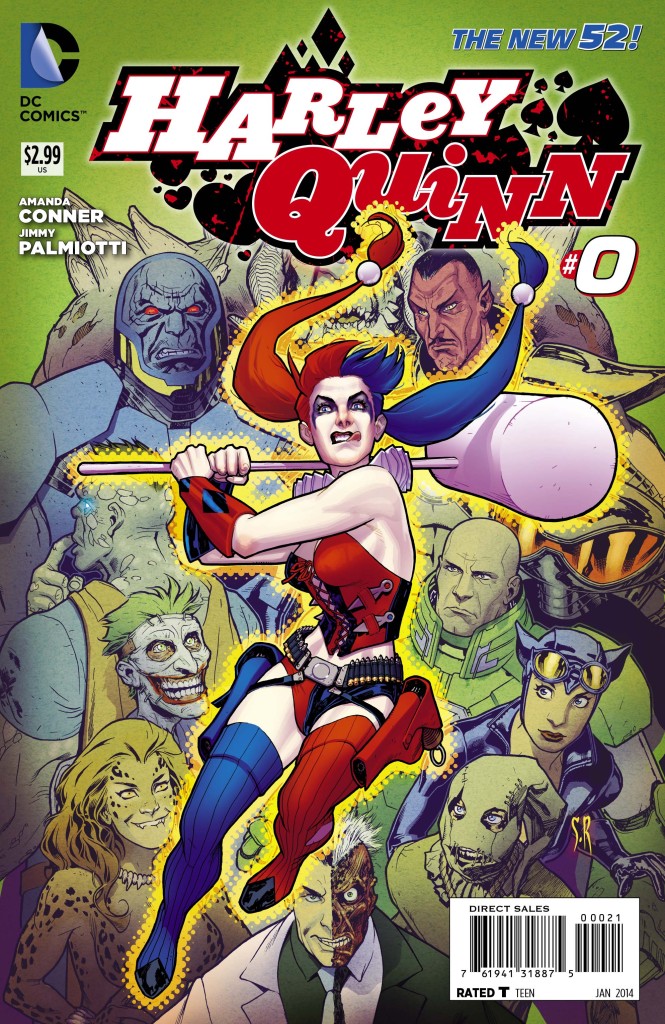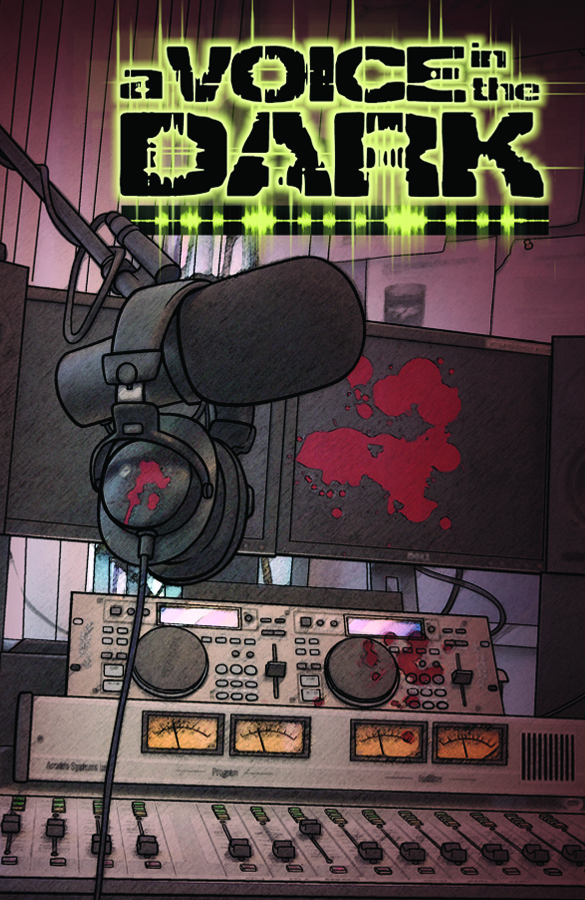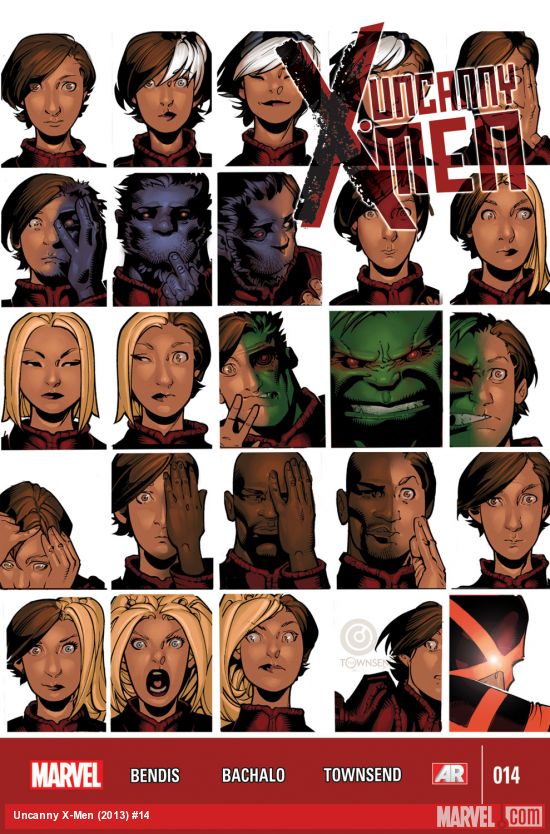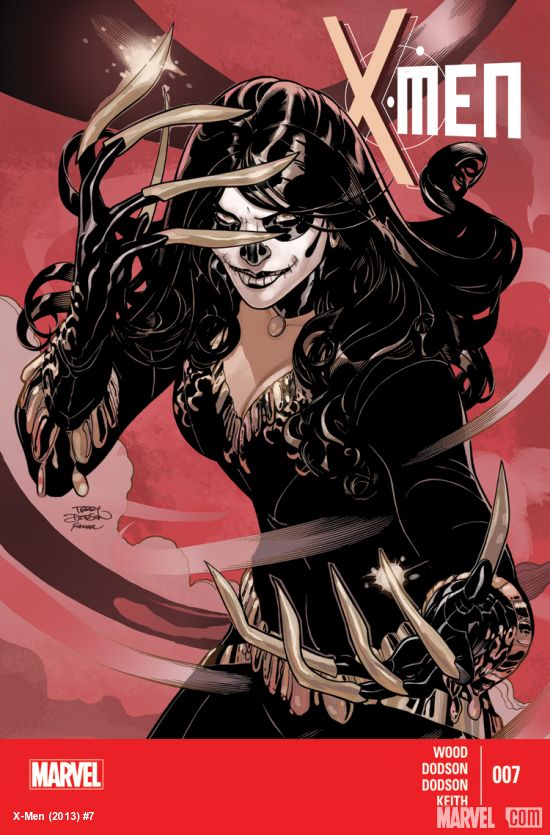We’re No. 1! is a weekly feature looking at first issues in new comic series, as well as one-offs and special releases. In his reviews, Jeff highlights stories with diverse characters and plot lines Geekquality readers can care about, as well as points out comics that miss the mark.
 This week sees the arrival of the much-discussed issue of Harley Quinn #0. The book created controversy earlier this year when DC Comics held a contest for aspiring artists to draw a single page featuring Harley in several dangerous situations, including nude in a bath on the verge of suicide. The uproar over the insensitivity led to apologies from DC and series co-writer Jimmy Palmiotti (the creator of another irreverent female comics character, Painkiller Jane). Having seen the completed work (with the offending panel idea replaced with artist Jeremy Roberts depicting Harley astride a rocket) it’s clear that the book is going for a very light feel. Harley is brought to life here by 17 different artists, one page at a time, in a never ending run of absurd situations. She constantly breaks the fourth wall and converses with the audience, as well as the writers directly, commenting on each rendition of her and the talents of the various artists. It is, all in all, a compelling way of letting readers know that this new series will redefine Harley as a character. By wandering about in dozens and dozens of looks and scenarios, she’s illustrating the mental instability that’s always been an integral part of the character, while uprooting any old notions readers might have about her, all in preparation for a new take. We’ll see how she fares when her issue #1 debuts in December.
This week sees the arrival of the much-discussed issue of Harley Quinn #0. The book created controversy earlier this year when DC Comics held a contest for aspiring artists to draw a single page featuring Harley in several dangerous situations, including nude in a bath on the verge of suicide. The uproar over the insensitivity led to apologies from DC and series co-writer Jimmy Palmiotti (the creator of another irreverent female comics character, Painkiller Jane). Having seen the completed work (with the offending panel idea replaced with artist Jeremy Roberts depicting Harley astride a rocket) it’s clear that the book is going for a very light feel. Harley is brought to life here by 17 different artists, one page at a time, in a never ending run of absurd situations. She constantly breaks the fourth wall and converses with the audience, as well as the writers directly, commenting on each rendition of her and the talents of the various artists. It is, all in all, a compelling way of letting readers know that this new series will redefine Harley as a character. By wandering about in dozens and dozens of looks and scenarios, she’s illustrating the mental instability that’s always been an integral part of the character, while uprooting any old notions readers might have about her, all in preparation for a new take. We’ll see how she fares when her issue #1 debuts in December.
 A Voice in the Dark #1, a project that was originally funded via Kickstarter by its creator, finds home at Image Comics this week. Creator Larime Taylor, previously interviewed on our site, brings us a story of a young college freshman named Zoey, who is struggling with sever mental illness and is on the cusp of becoming a serial killer. In her diary, she writes, “It’s been 72 days since I killed someone.” Zoey wants to make sure that her last victim – a young woman who savagely bullied and outed her adopted younger sister – is also her last. Having joined the campus radio station, Zoey establishes a late night talk-show for anonymously airing grievances and issues, and she hopes to find a more peaceful way of expression for her dark side. Zoey is a fascinating character who defies the mold of the stereotypical serial killer on almost every count, but her originality is in some ways a detriment to the story. Coming from a loving and supportive family in particular, she didn’t suffer abuse, and she also tells us she never tortured animals as a child. For her to suddenly develop a lack of conscience as a young adult is highly unusual, if we consider what is generally understood of the pathology of serial killers. Taylor’s attempt to turn the serial killer mold on its ear does strain the credibility of the narrative a bit, but might offer insight into the character in the long term. Perhaps Zoey will realize that there’s more going on with her than she might be aware of, as the narrator of her own story. There is also more character diversity here than you can shake a bloody knife at, and overall, the book is not one to miss.
A Voice in the Dark #1, a project that was originally funded via Kickstarter by its creator, finds home at Image Comics this week. Creator Larime Taylor, previously interviewed on our site, brings us a story of a young college freshman named Zoey, who is struggling with sever mental illness and is on the cusp of becoming a serial killer. In her diary, she writes, “It’s been 72 days since I killed someone.” Zoey wants to make sure that her last victim – a young woman who savagely bullied and outed her adopted younger sister – is also her last. Having joined the campus radio station, Zoey establishes a late night talk-show for anonymously airing grievances and issues, and she hopes to find a more peaceful way of expression for her dark side. Zoey is a fascinating character who defies the mold of the stereotypical serial killer on almost every count, but her originality is in some ways a detriment to the story. Coming from a loving and supportive family in particular, she didn’t suffer abuse, and she also tells us she never tortured animals as a child. For her to suddenly develop a lack of conscience as a young adult is highly unusual, if we consider what is generally understood of the pathology of serial killers. Taylor’s attempt to turn the serial killer mold on its ear does strain the credibility of the narrative a bit, but might offer insight into the character in the long term. Perhaps Zoey will realize that there’s more going on with her than she might be aware of, as the narrator of her own story. There is also more character diversity here than you can shake a bloody knife at, and overall, the book is not one to miss.
 Beyond that, there was little excitement as far as #1 issues were concerned. Thankfully, two books from the same family deserve a spot in our Honorable Mentions. Uncanny X-Men #14 is centered on a young mutant named Benjamin Deeds, who can morph his body to take on the physical shape of anyone he is close to, to a certain degree. His teachers, in particular the formerly villainous Emma Frost, feel there is more to him than even he knows, however. By pushing him to learn more about his gift, they help Benjamin discover that he can not only adapt his physical appearance to be similar to another person’s, but that he gives off an “energy” that puts that person at ease. When tasked with using this ability to pick up a young woman in a bar as a training exercise, Benjamin comes out to Frost, telling her that he is gay. Her response is short and to the point, “I don’t care.” Frost doesn’t feel that his sexual orientation is relevant to doing his job as an X-Man, in this or any other situation. The entire story, written by Brian Michael Bendis with art by Chris Bachalo, provides a subtle look at the challenges of blending in and being accepted by others. Benjamin’s mutant abilities aren’t any more dependent on his orientation than any other part of his life might be. Neither is his status as a member of the X-Men, in many ways his chosen profession, nor should they be. Ben’s homosexuality is certainly a defining part of his nature, and he struggles with being asked to be something he’s not. However, for a character whose mutant ability is exactly that – becoming something and someone else over and over again – these struggles are put in an entirely original and sympathetic light.
Beyond that, there was little excitement as far as #1 issues were concerned. Thankfully, two books from the same family deserve a spot in our Honorable Mentions. Uncanny X-Men #14 is centered on a young mutant named Benjamin Deeds, who can morph his body to take on the physical shape of anyone he is close to, to a certain degree. His teachers, in particular the formerly villainous Emma Frost, feel there is more to him than even he knows, however. By pushing him to learn more about his gift, they help Benjamin discover that he can not only adapt his physical appearance to be similar to another person’s, but that he gives off an “energy” that puts that person at ease. When tasked with using this ability to pick up a young woman in a bar as a training exercise, Benjamin comes out to Frost, telling her that he is gay. Her response is short and to the point, “I don’t care.” Frost doesn’t feel that his sexual orientation is relevant to doing his job as an X-Man, in this or any other situation. The entire story, written by Brian Michael Bendis with art by Chris Bachalo, provides a subtle look at the challenges of blending in and being accepted by others. Benjamin’s mutant abilities aren’t any more dependent on his orientation than any other part of his life might be. Neither is his status as a member of the X-Men, in many ways his chosen profession, nor should they be. Ben’s homosexuality is certainly a defining part of his nature, and he struggles with being asked to be something he’s not. However, for a character whose mutant ability is exactly that – becoming something and someone else over and over again – these struggles are put in an entirely original and sympathetic light.
 Brian Wood introduces an all-new version of the villain Lady Deathstrike to his ongoing all-female cast in X-Men #7. The events of the recent crossover Battle of the Atom have cost this iteration of X-men their longtime stalwart Kitty Pryde. Wood and husband and wife art team Terry and Rachel Dodson have replenished the ranks with a pair of women of color. The first is former Omega Sentinel Karima Shapandar, an Indian woman who was a police detective before being cybernetically altered. She is joined by Monet St. Croix, the Muslim X-Man sometimes known as M, who is of Afro-European and Algerian descent. Wood’s new iteration of Lady Deathstrike is a Colombian woman named Ana Cortes, a wealthy heiress who has inherited her father’s vast empire. Ana is implanted with the mind, memories and abilities of the first Lady Deathstrike, Yuriko Oyama. She takes on a fearsome look in her new form, combining traditional Day of the Dead makeup with her lethal razor tipped fingers. Combined with Yuriko, she is now hungry for power and ready to destroy the X-Men to get it. The women here aren’t just “strong female characters” and their cultural and religious identities are an integral part. Both Karima and Monet are women of faith, and these characters have been used as allegory for modern day religious differences in the past. It will be interesting to see if Wood continues to do so.
Brian Wood introduces an all-new version of the villain Lady Deathstrike to his ongoing all-female cast in X-Men #7. The events of the recent crossover Battle of the Atom have cost this iteration of X-men their longtime stalwart Kitty Pryde. Wood and husband and wife art team Terry and Rachel Dodson have replenished the ranks with a pair of women of color. The first is former Omega Sentinel Karima Shapandar, an Indian woman who was a police detective before being cybernetically altered. She is joined by Monet St. Croix, the Muslim X-Man sometimes known as M, who is of Afro-European and Algerian descent. Wood’s new iteration of Lady Deathstrike is a Colombian woman named Ana Cortes, a wealthy heiress who has inherited her father’s vast empire. Ana is implanted with the mind, memories and abilities of the first Lady Deathstrike, Yuriko Oyama. She takes on a fearsome look in her new form, combining traditional Day of the Dead makeup with her lethal razor tipped fingers. Combined with Yuriko, she is now hungry for power and ready to destroy the X-Men to get it. The women here aren’t just “strong female characters” and their cultural and religious identities are an integral part. Both Karima and Monet are women of faith, and these characters have been used as allegory for modern day religious differences in the past. It will be interesting to see if Wood continues to do so.

